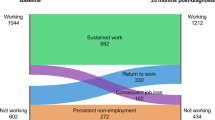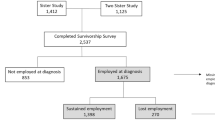Abstract
Low-income women may be especially vulnerable to job loss after a breast cancer diagnosis. The identification of early risk factors for not returning to work in the long term could inform interventions to help survivors avoid this outcome. A consecutive sample of low-income, employed, underinsured/uninsured women treated for stage 0–III breast cancer was surveyed 6, 18, 36, and 60 months after diagnosis. Participants were classified according to the survey in which they first reported return to work. If they were not working in every survey they were classified as not returning to work. Correlates of not returning to work were identified. Of 274 participants, 36 % returned to work by 6 months, an additional 21 % by 18, 10 % by 36, and 5 % by 60 months. 27 % never returned to work. Of those not working at 6 months, 43 % never returned. Independent predictors of never returning to work included lowest annual income (<$10,000), Latina ethnicity, high comorbidity burden, and receipt of chemotherapy. Very poor women who stop working during chemotherapy for breast cancer are at risk of not returning to work months and years following treatment. These findings may have clinical and policy implications. Conversely, radiation therapy, axillary node dissection, age, and job type do not appear to be associated with return to work. Clinicians should discuss work-related concerns with patients and facilitate early return to work when desired by the patient. Additional research is needed to develop interventions to optimize return to work.



Similar content being viewed by others
References
Blinder V, Patil S, Thind A, Diamant A, Hudis C, Basch E, Maly R (2012) Return to work in low-income latina non-latina white breast cancer survivors: a three-year longitudinal study. Cancer 118(6):1664–1674. doi:10.1002/cncr.26478
Engel J, Kerr J, Schlesinger-Raab A, Eckel R, Sauer H, Holzel D (2003) Predictors of quality of life of breast cancer patients. Acta Oncol 42(7):710–718
Feuerstein M, Todd BL, Moskowitz MC, Bruns GL, Stoler MR, Nassif T, Yu X (2010) Work in cancer survivors: a model for practice and research. J Cancer Surviv 4(4):415–437. doi:10.1007/s11764-010-0154-6
Mujahid MS, Janz NK, Hawley ST, Griggs JJ, Hamilton AS, Graff J, Katz SJ (2011) Racial/ethnic differences in job loss for women with breast cancer. J Cancer Surviv 5(1):102–111. doi:10.1007/s11764-010-0152-8
Bouknight RR, Bradley CJ, Luo Z (2006) Correlates of return to work for breast cancer survivors. J Clin Oncol 24(3):345–353
Satariano WA, DeLorenze GN (1996) The likelihood of returning to work after breast cancer. Public Health Rep 111(3):236–241
Bradley CJ, Neumark D, Bednarek HL, Schenk M (2005) Short-term effects of breast cancer on labor market attachment: results from a longitudinal study. J Health Econ 24(1):137–160
Mujahid MS, Janz NK, Hawley ST, Griggs JJ, Hamilton AS, Katz SJ (2010) The impact of sociodemographic, treatment, and work support on missed work after breast cancer diagnosis. Breast Cancer Res Treat 119(1):213–220. doi:10.1007/s10549-009-0389-y
Drolet M, Maunsell E, Brisson J, Brisson C, Masse B, Deschenes L (2005) Not working 3 years after breast cancer: predictors in a population-based study. J Clin Oncol 23(33):8305–8312. doi:10.1200/jco.2005.09.500
Peuckmann V, Ekholm O, Sjogren P, Rasmussen NK, Christiansen P, Moller S, Groenvold M (2009) Health care utilisation and characteristics of long-term breast cancer survivors: nationwide survey in Denmark. Eur J Cancer 45(4):625–633. doi:10.1016/j.ejca.2008.09.027
Chen J, Diamant A, Thind A, Maly R (2008) Determinants of breast cancer knowledge among newly diagnosed, low-income, medically underserved women with breast cancer. Cancer 112(5):1153–1161
Eremenco SL, Cella D, Arnold BJ (2005) A comprehensive method for the translation and cross-cultural validation of health status questionnaires. Eval Health Prof 28(2):212–232
Ganz PA, Desmond KA, Leedham B, Rowland JH, Meyerowitz BE, Belin TR (2002) Quality of life in long-term, disease-free survivors of breast cancer: a follow-up study. J Natl Cancer Inst 94(1):39–49
Seeman TE, Berkman LF (1988) Structural characteristics of social networks and their relationship with social support in the elderly: who provides support. Soc Sci Med 26(7):737–749
Marin G, Sabogal F, Marin B, Otero-Sabogal R, Perez-Stable E (1987) Development of a short acculturation scale for hispanics. Hispanic J Behav Sci 9(2):183–205
United States Census Bureau Index of Occupations (2002) http://www.census.gov/hhes/www/ioindex/ioindex02/occ02_a.html. Accessed 17 Apr 2009
Health and Retirement Study (1995) Ahead core, final, version 2.0, May 2002, revised August 2007, master codes. http://hrsonline.isr.umich.edu/modules/meta/1995/core/codebook/a95_mastercode.htm. Accessed 17 Apr 2009
Chirikos TN, Russell-Jacobs A, Cantor AB (2002) Indirect economic effects of long-term breast cancer survival. Cancer Pract 10(5):248–255
Ashing-Giwa KT, Tejero JS, Kim J, Padilla GV, Hellemann G (2007) Examining predictive models of HRQOL in a population-based, multiethnic sample of women with breast carcinoma. Qual Life Res 16(3):413–428
Charlson ME, Pompei P, Ales KL, MacKenzie CR (1987) A new method of classifying prognostic comorbidity in longitudinal studies: development and validation. J Chronic Dis 40(5):373–383
Katz JN, Chang LC, Sangha O, Fossel AH, Bates DW (1996) Can comorbidity be measured by questionnaire rather than medical record review? Med Care 34(1):73–84
Bureau of Labor Statistics, US Department of Labor (2011) Employee Benefits in the United States–March 2011, USDL-11-1112. http://www.bls.gov/ncs/ebs/sp/ebnr0017.pdf. Accessed 15 May 2012
Maly RC, Liu Y, Leake B, Thind A, Diamant AL (2010) Treatment-related symptoms among underserved women with breast cancer: the impact of physician-patient communication. Breast Cancer Res Treat 119(3):707–716. doi:10.1007/s10549-009-0418-x
The Americans with Disabilities Act of 1990, Titles I and V (1990) http://www.eeoc.gov/laws/statutes/ada.cfm. Accessed 10 July 2007
Brown RF, Owens M, Bradley C (2013) Employee to employer communication skills: balancing cancer treatment and employment. Psychooncology 22(2):426–433. doi:10.1002/pon.2107
Hewitt M, Greenfield S, Stovall E (2006) From cancer patient to cancer survivor: lost in transition. National Academies Press, Washington, DC
Greenhouse S (2013) Labor sees bright spots in membership trends. The New York Times, January 28
Acknowledgments
The authors gratefully acknowledge Paige Nobles for assistance with graphics.
Conflict of interest
The authors have no conflicts of interest to disclose.
Funding
American Cancer Society (TURSG-02-081); California Breast Cancer Research Program (7PB-0070); National Cancer Institute (1R01CA119197-01A1 and 1R01CA140481-01A1); American Cancer Society (MRSGT-11-002-01-CPHPS); American Society of Clinical Oncology (CDA, Blinder).
Author information
Authors and Affiliations
Corresponding author
Rights and permissions
About this article
Cite this article
Blinder, V., Patil, S., Eberle, C. et al. Early predictors of not returning to work in low-income breast cancer survivors: a 5-year longitudinal study. Breast Cancer Res Treat 140, 407–416 (2013). https://doi.org/10.1007/s10549-013-2625-8
Received:
Accepted:
Published:
Issue Date:
DOI: https://doi.org/10.1007/s10549-013-2625-8




